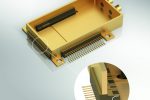Sensitive optoelectronic components used in the high-speed data and telecommunication industries, especially in the radio frequency (RF) range, require reliable protection in a harsh environment. Increasing miniaturization adds to the challenging requirements of customizing packaging designs. That is why SCHOTT resorts to sophisticated multilayer ceramic structures to solve interconnection problems in high-density packaging.
Used as hermetic feedthroughs, multilayer ceramics are ideal to bridge the height difference of the planar waveguide for the signal path inside the housing and the host board, while keeping the RF path reflection at a minimal level. They also allow for complex structures of electrical, optical, and thermal interfaces to be integrated into the housing. Common butterfly packages, on the contrary, required cut-outs in the host board or bent leads – options, which for technical, design and assembly reasons were not ideal.
Designing compactness
“Multilayer ceramics are well-suited for compact systems in high frequency applications,” says Robert Hettler, Head of R&D Opto-Electronics at SCHOTT Electronic Packaging. “They allow for connecting a high number of conductors to create a dense routing inside a hermetically sealed unit,” Hettler adds. To realize this unit, metallic lines and vias are applied to thin sheets of ceramic with the help of punching processes and silk screen printing. Several layers are then stacked, laminated and co-fired at high temperatures. A device is formed that can be mounted on the surface of a printed circuit board (PCB).
Recently, SCHOTT developed a space-saving, standard-looking surface-mount device with a bandwidth greater 30 GHz allowing for a highly customizable design of the package interior. Using Finite Element simulation tools to analyze the electromagnetic field, SCHOTT is able to model the most suitable packaging. The signal path quality can thus be improved before a prototype is actually created; shortening the time-to-market and enabling enhanced designs of hermetic hybrid packages.
Additional information: http://www.schott.com/epackaging /
Download link to a ZIP file that contains this picture in print quality:
http://www.schott-pictures.net/presskit/210943.empc2013 /, More press photographs available here: http://www.schott-pictures.net/


